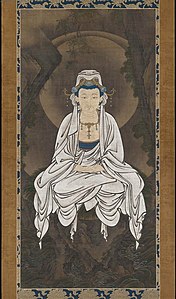अवलोकितेश्वर

अवलोकितेश्वर महायान बौद्ध धर्म सम्प्रदाय के सबसे लोकप्रिय बोधिसत्वों में से एक हैं। उनमें अनन्त करुणा है और धर्म-कथाओं में कहा गया है कि बिना संसार के समस्त प्राणियों का उद्धार किये वे स्वयं निर्वाण लाभ नहीं करेंगे। कहा जाता है कि अवलोकितेश्वर अपनी असीम करुणा में कोई भी रूप धारण कर के किसी दुखी प्राणी की सहायता के लिए आ सकते हैं।[1] महायान बौद्ध ग्रंथ सद्धर्मपुण्डरीक में 'अवलोकितेश्वर बोधिसत्व' के माहात्म्य का चमत्कारपूर्ण वर्णन मिलता है। चीनी धर्मयात्री फ़ाहियान ३९९ ई॰ में जब भारत आए थे तब उन्होंने सभी जगह अवलोकितेश्वर की पूजा होते देखी। [उद्धरण चाहिए]
भगवान् बुद्ध ने बराबर अपने को मानव के रूप में प्रकट किया और लोगों को प्रेरित किया कि वे उन्हीं के मार्ग का अनुसरण करें। अवलोकितेश्वरों में महत्वपूर्ण सिंहनाद की उत्तर मध्यकालीन (लगभग ११वीं सदी) असाधारण सुन्दर प्रस्तरमूर्ति लखनऊ संग्रहालय में सुरक्षित है।[2] अवलोकितेश्वर को अक्सर एक कमल का फूल पकड़े हुए दर्शाया जाता है और कथाओं में उनकी 'कमल-प्रकृति' का अक्सर वर्णन मिलता है जो किसी भी वातावरण में प्राणियों को सौंदर्य, सुगंध और उद्धार की ओर ले जाती है।[3]
चित्रावली
[संपादित करें]-
तीसरी शताब्दी की गांधार शैली में निर्मित अवलोकितेश्वर प्रतिमा
-
भारतीय गुफाओं की भित्ति पर अवलोकितेश्वर का चित्र ; अजन्ता गुफाएँ, ६ठी शताब्दी
-
Avalokitesvara, ca 11th-12th Century CE, Pala Period
-
Avalokitesvara, Pala period
-
Cambodian statue of Avalokiteśvara. Sandstone, 7th century CE.
-
Avalokiteśvara sandstone statue, late 7th century CE.
-
Eight-armed Avalokiteśvara, ca. 12th-13th century (Bàyon). The Walters Art Museum.
-
Avalokiteśvara from Bingin Jungut, Musi Rawas, South Sumatra. Srivijayan art (c. 8th-9th century CE)
-
The bronze torso Avalokiteshvara of Chaiya, 8th century CE Srivijayan art, Chaiya District, Surat Thani Province, Southern Thailand.
-
The Privy Seal of King Ananda Mahidol of Thailand show a picture of a Bodhisattva, based on a Srivijayan sculpture of Avalokiteśvara Padmapani which was found at Chaiya District, Surat Thani Province.
-
Chinese statue of Avalokiteśvara looking out over the sea, c. 1025 CE.
-
Senju Kannon by Tankei, 13th century, Sanjūsangen-dō, Japan.
-
Nyoirin Kannon, 1275, Tokyo National Museum, Japan
-
Korean painting of Avalokiteśvara. Kagami Jinjya, Japan, 1310 CE.
-
Nepalese statue of Avalokiteśvara with six arms. 14th century CE.
-
Avalokiteśvara of One Thousand Arms, lacquered and gilded wood. Restored in 1656 CE. Bút Tháp Temple, Bắc Ninh Province, Vietnam
-
Tibetan statue of Avalokiteśvara with eleven faces.
-
Japanese painting of Avalokiteśvara meditating. 16th century CE.
-
Tang dynasty (896 AD) carved stone statue of Qianshou Guanyin in Shengshui Temple (內江聖水寺) in Neijiang, Sichuan, China
-
The world tallest octagonal pavilion to shelter the Guanyin statue in Kek Lok Si in Air Itam, Penang, Malaysia.
-
Esoteric Cundī form of Avalokiteśvara with eighteen arms in Lingyin Temple in Hangzhou, Zhejiang Province, China.
-
Thousand-armed Avalokiteśvara bronze statue from Tibet, circa 1750. Birmingham Museum of Art
-
Quan Âm (Avalokiteśvara) statue in the 18th - 19th centuries at the Vietnam National Museum of History, Hanoi, Vietnam
-
2 statues of Quan Âm (Avalokiteśvara) in the Nguyễn dynasty at the Vietnam National Museum of History, Vietnam
-
Quán Âm (Avalokiteśvara) figurine, Bát Tràng kiln, Hanoi, Nguyễn dynasty, 19th century AD, white glazed ceramic - Vietnam National Museum of History, Vietnam
-
Mongolian statue of Avalokiteśvara (Migjid Janraisig). Tallest indoor statue in the world, 26.5-meter-high, 1996 rebuilt, (1913)
-
Statue of Ruyilun Guanyin (Cintamanicakra) in the Buddha Tooth Relic Temple and Museum in Chinatown, Singapore.
-
Statue of Avalokiteśvara, date unknown, bronze and gold
-
Painting of Avalokitesvara Bodhisattva. Sanskrit Astasahasrika Prajnaparamita Sutra manuscript written in the Ranjana script. Nalanda, Bihar, India. Circa 700-1100 CE
-
Statue of Shiyimian Guanyin in Ten Thousand Buddhas Monastery (萬佛寺) in Pai Tau Village, Sha Tin, Hong Kong
-
The wooden statue of thousand-armed and thousand-eyed Guanyin at the City of Ten Thousand Buddhas in Ukiah, California.
इन्हें भी देखें
[संपादित करें]बाहरी कड़ियाँ
[संपादित करें]- पोताला के अवलोकितेश्वर का स्रोत (अंग्रेज़ी में)
- 'अवलोकितेश्वर' नाम की व्याख्या (अंग्रेज़ी)
- करुणा के बोधिसत्व और अमिताभ का आत्मिक तेज (अंग्रेज़ी में)
- कम्बोडिया के बयोन मंदिर में अवलोकितेश्वर का ख्मेर नरेश जयवर्मन ७ के रूप में प्रदर्शन
- अवलोकितेश्वर का एक सुनेहरा चित्रण
सन्दर्भ
[संपादित करें]- ↑ The Silk Road: trade, travel, war and faith Archived 2016-04-26 at the वेबैक मशीन, Susan Whitfield, British Library, Serindia Publications, Inc., 2004, ISBN 978-1-932476-13-2, ... Avalokitesvara, the embodiment of compassion, is one of the most popular of the Mahayana bodhisattvas. The ability of Avalokitesvara to take any form in order to come to the aid of sentient beings is described in chapter twenty-five of the Lotus Sutra ...
- ↑ Ultimate Healing: The Power of Compassion[मृत कड़ियाँ], Lama Zopa Rinpoche, Ailsa Cameron, Wisdom Publications, 2001, ISBN 978-0-86171-195-6, ... The original practice contained the mantras of Sitatapatra (White Umbrella Deity) and Singhanada (Lion's Roar Avalokiteshvara) ...
- ↑ The origins of Oṃ maṇipadme hūṃ: a study of the Kāraṇḍavyūha sūtra, Alexander Studholme, SUNY Press, 2002, ISBN 978-0-7914-5389-6, ... The symbol of the lotus continues to appear throughout the Kararidavyuha Sutra. Avalokitesvara himself is repeatedly described in terms of his 'lotus' qualities ...





































